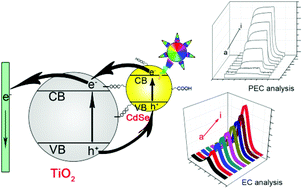Construction of dentate bonded TiO2–CdSe heterostructures with enhanced photoelectrochemical properties: versatile labels toward photoelectrochemical and electrochemical sensing†
Abstract
A facile synthetic route for TiO2–CdSe heterostructures was proposed based on dentate binding of TiO2 to carboxyl. Carboxyl functionalized CdSe quantum dots (CF-CdSe QDs) were successfully bonded onto TiO2 nanoparticles (NPs), which could significantly improve the photoelectrochemical (PEC) properties of TiO2 NPs. This is ascribed to the fact that CdSe QDs with a narrow band gap could be stimulated under visible light irradiation, and the energy levels of TiO2 NPs and CF-CdSe QDs are aligned with an electrolyte solution. High resolution transmission electron microscopy images revealed the heterostructures of the TiO2–CdSe composites. Ultraviolet visible spectroscopy, photoluminescence emission spectroscopy and electrochemical impedance spectroscopy analysis exhibited that the prepared TiO2–CdSe heterostructures have improved light absorption, charge separation efficiency and electron transfer ability in the visible light region. TiO2–CdSe heterostructures were used as versatile labels for fabrication of PEC and electrochemical immunosensors, and human immune globulin G (HIgG) was used as a model analyte. The immunosensor showed high sensitivity, a low detection limit and a wide linear range, which could be applied in practical serum sample analysis. The constructed TiO2–CdSe heterostructures would have potential applications in photocatalysis, aptasensors, cytosensors and other areas of nanotechnology.


 Please wait while we load your content...
Please wait while we load your content...